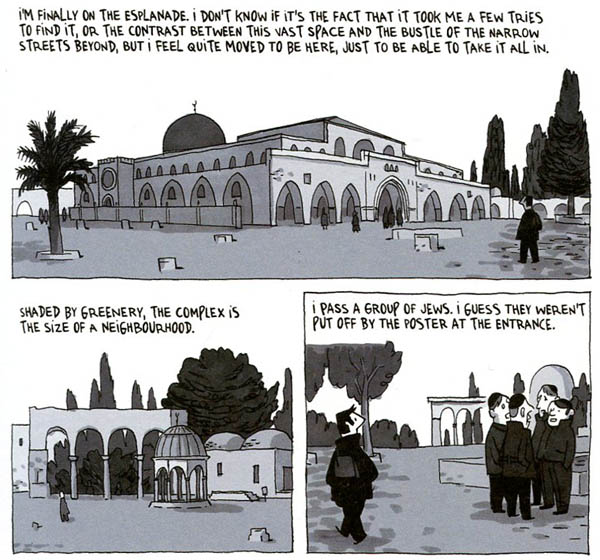 By Guy Delisle
By Guy Delisle
336 pages, color
Published by Drawn & Quarterly
I’ve always enjoyed travel non-fiction, and that’s definitely what Guy Delisle’s books set in different parts of the world fall under. Books like Pyongyang: A Journey in North Korea and Burma Chronicles have given us glimpses into these far-off, almost-inaccessible places, mixing local color with the travails of his own life. With Jerusalem: Chronicles from the Holy City, though, he’s going to a place that feels a little closer if perhaps also more volatile. The chances of knowing someone who’s gone to Burma or North Korea are small at best, but Jerusalem (and to a lesser extent, Israel, the West Bank, and Gaza in general) is a much higher probability. So in doing so, Delisle loses his previous "edge" of transporting the reader to a place they’ll almost certainly never visit, and has to rely more on his own storytelling ability.
In Jerusalem, Delisle and his family are moving to East Jerusalem for the same reason they’d gone to Burma; his wife Nadège’s job at Médecins Sans Frontières. For those unfamiliar with the breakdown of Jerusalem, as Delisle himself relates to the reader early on, it’s a portion of the city that was annexed into Jerusalem in the 1967 war but is considered by most of the world as being part of Palestine. As we quickly see from Delisle’s attempts to navigate the city, this means going through checkpoints and barriers constantly, something that his own neighbors can’t so easily pass through. From there, it’s a whirlwind of learning local customs from a number of religions, balancing the wildly differing schedules of Nadège and their children, and what to do whenever the Israelis and Palestinians have armed conflicts break out.
Those looking for a deep, interesting view of the politics between Israel and Palestine should look elsewhere, although to be fair it’s not what Delisle is promising. There are a lot of non-fiction graphic novels set in the region, like Joe Sacco’s Palestine and Footnotes in Gaza (both of which are distinctly journalism), or Sarah Glidden’s How to Understand Israel in 60 Days or Less (a personal journey about Glidden’s understanding and feelings towards Israel). Delisle’s is travel writing, which means that the focus is on giving us a glimpse of what it’s like to live in Jerusalem on a day-to-day basis. This means suffering alarms, accidentally driving into an ultra-orthodox Jewish neighborhood during the Sabbath, or learning how to navigate El Al’s customs agents every time he tries to fly back into the country. This is, after all, a narrator who doesn’t know what Yom Kippur is before moving to Jerusalem, and at one point on a map labels Lebanon as Libya. You aren’t going to get deep political discussion in Jerusalem, but that’s not necessarily a bad thing.

What we do get, though, is a slow transformation from frustration to acceptance to almost (but not quite) fitting in to the strange world that is East Jerusalem. Once Delisle starts finding places to use as a studio (in a most unlikely location at that) and settling into a routine, his life actually gets more interesting rather than less. I think it’s because with a lot of that initial frustration having faded away it lets him start to notice some of the smaller and more interesting details about the world around him. Near the end, Delisle wistfully notes that had he and his family stayed for a second year, things would have been much easier, and it’s easy to see that being true. That initial struggle evaporating turns his journal into a much more personal piece; something as simple as building piles of stones and finding a turtle can be just as interesting as being shown where a group of Jews have temporarily stored their new foundation stones for building the Third Temple.
Delisle’s art is simple and iconic, which is a great style when it comes to a personal journal. When drawing himself it’s just two dots for eyes, a point for a nose, and a simple line for a mouth, Instead he puts the focus on just the right things at the right time; the clothing being worn, the buildings that make up Jerusalem, the landscape that surrounds them. It keeps your attention centered, and Delisle himself is able to fade into the background when necessary, then burst back to the foreground for a reaction shot. Delisle’s art shifts between two-color and full-color, with the latter reserved for historical flashbacks, maps, and moments of accent. It’s a curious decision but it does make those moments stand out particularly well. I’d love to see a full-color book from Delisle—I think his usage of flat colors is an attractive mix with his simple style—but for now I’ll settle for what I can get.

Jerusalem: Chronicles from the Holy City is a book that when read as a travel journal hits all the right spots. It’s not Delisle’s best (that’s probably still Pyongyang), but I think Jerusalem could definitely battle with Burma Chronicles for an easy second place finish. Delisle’s travels pull the reader in just the right way, so that you can almost project yourself into the setting. Jerusalem might not be as remote as some of his other destinations that he’s written about, but ultimately it’s still a satisfying read.
Purchase Links: Amazon.com | Powell’s Books
